
Photo Credit: Sadie Tresnit
It’s a scene many Franklin students know all too well. You’ve finally made it school and you’re walking to the door when all of a sudden, a blade of water from the sprinklers cuts across your path, soaking your clothes and ruining your day before it’s even had a chance to start.
Many students have expressed concerns over the placement and seemingly excessive nature of the Franklin sprinklers. They’re environmentally unsound due to their locale and scheduled outbursts, and constantly inconvenience students. Which should a school value more? Academics or grass? When phrased as such, the choice seems easy, but our school continues to waste unnecessary resources on pure aesthetics.
First of all, the sprinklers have an unfortunate habit of soaking students due to their close proximity to the sidewalks. “Unless the school is attempting to keep students hydrated through contact with water on their skin then I cannot understand why the sprinklers are used so poorly,” says one anonymous Franklin sophomore. “Once I was walking and literally the second I stepped a few inches away from the sprinkler, it broke and burst up like a geyser, and if I had been there two seconds before, it would’ve gone up my skirt,” says Parker MacLeod (10). Of course, when students aren’t around to absorb the excess water, it goes straight to the cement. This is problematic because it’s a blatant waste of water, which is a precious resource.
That’s another complaint students have: the sprinklers are damaging to the environment. “Sprinklers aren’t a very efficient or valid use of [water],” says MacLeod. “And I think that the grass we have isn’t inherently a bad thing, but it’s so bad for bees because it doesn’t have pollen, and it takes so much water to maintain. There are so many better things you can have, like a new kind of succulent turf that’s being made. There are tons of pollinator-friendly types of groundcover. I think [the sprinklers] create more havoc than they’re worth.” In one hour, a sprinkler can use the amount of water that a four person family uses in one day (approximately 320 to 400 gallons).
However, the Franklin sprinklers aren’t completely bad. They certainly appear to keep the grass healthy and green, preserving the pristine image of our picture-perfect new school. Grass covers a large portion of the school’s land, and it would almost certainly be noticeable if it was watered less meticulously. “Sometimes, especially if sprinklers don’t use clean drinking water, they can be effective,” says Franklin physics teacher Scott Barrentine.
Unfortunately, the constant watering could actually be detrimental to the school’s appearance. As many students have noticed, when the grass has recently been watered, which is most of the time, it becomes slippery. If the current sprinkler schedule is kept up, “there will be erosion, and there will be students falling, and huge swaths of grass that fall out when you step on them,” says sophomore Sage Freewynn.
In summary, while the sprinklers at Franklin have a few positive effects, the negative effects far outweigh them. The sprinklers are a waste of valuable resources, are bad for the environment, and frequently inconvenience anyone trying to navigate the school. As more and more students complain about the issue, the school administration must address it.

































